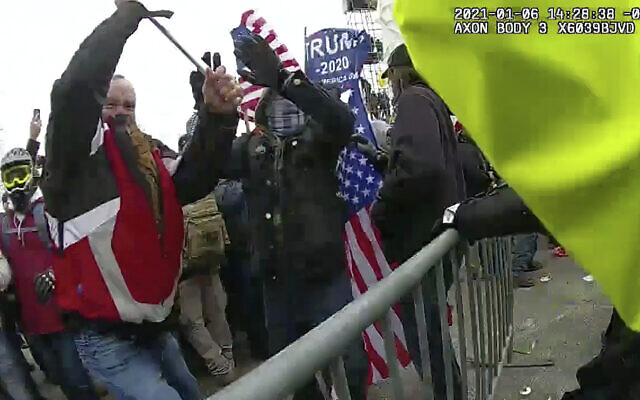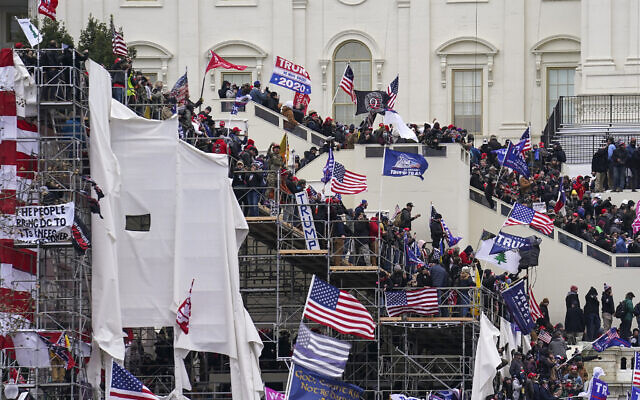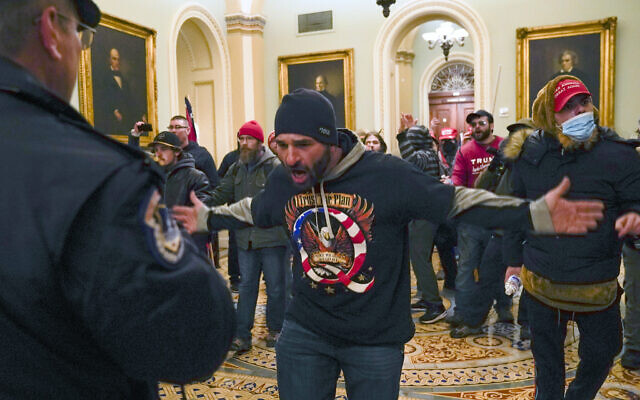PHOENIX (AP) – They pretended their involvement in the January 6 riots at the US Capitol on social media and then, apparently realizing they were in legal trouble, rushed to remove evidence, officials say is. Now his attempts to hide his role in the deadly siege are likely to come back to haunt him in court.
An Associated Press review of court records has found that at least 49 defendants are accused of trying to erase objectionable photos, videos and text from phone or social media accounts documenting their conduct as Donald Trump The mob stormed the Congress and briefly blocked the certification. Democrat Joe Biden’s electoral victory.
Experts say efforts to scavenge social media accounts show these people have a desperate desire to manipulate evidence when they find out they are in hot water. And, he says, it can serve as powerful evidence of people’s sense of guilt and make it harder to negotiate plea deals and seek leniency on sentencing.
Gabriel J., who teaches criminal law at the University of California, Davis. “It makes them look difficult, they look timid,” Chin said.
Authorities say one such defendant is James Breheney, a member of the Oath Keepers extremist group, who bragged in texts to others about being inside the Capitol during the rebellion. According to court documents, an aide instructed Breheny to “delete all photos, messages and get a new phone” in an encrypted message two days after the riots.
The same day, the FBI said, Brehany shut down his Facebook account, where he had photos taken during the riots, and complained that the government had become tyrannical. “The duty of the people is to change the government they agree to,” Brehney wrote on Facebook in an exchange about the riots on 6 January. “I hear. What options do we have???”
Breheney’s attorney, Harley Breit, said that his client never obstructed the investigation of the riots or destroyed evidence, and Breheney did not know when he closed the account that his material would be considered evidence.
Breit rejected the notion that Brehaney might have been able to identify in the days immediately after January 6, when the riot dominated news coverage, that the attack was a serious situation that could have threatened Brehany’s independence.

This still frame from the Metropolitan Police Department body worn camera video shows Thomas Webster in a red jacket at a barricade line on the western front of the US Capitol on January 6, 2021 in Washington (Metropolitan Police Department via AP)
“If you don’t know that you’re being accused of anything, you can’t remove the evidence,” Breit said.
According to court documents, the other defendants who have not been charged with destruction of evidence are still engaged in exchanges with others about the removal of material.
The FBI said a woman who posted videos and comments showing she was inside the Capitol during the attack later decided not to restore her new phone with her iCloud content — a move that officials said. suspected that the material was intended to be prevented from being exposed.
In another case, officials say a screenshot of a deleted Facebook post from a North Carolina man contradicted his claim during an interview with an FBI agent that he did not intend to obstruct Electoral College certification.
Deleting digital content isn’t as simple as deleting content from a phone, deleting social media posts, or closing accounts. Investigators have been able to retrieve digital content by requesting social media companies even after the accounts were closed.

This January 6, 2021, rioters loyal to US President Donald Trump stormed the US Capitol in Washington. The impeachment trial of Donald Trump has begun debate on Tuesday, February 9 after he incited the violent mob that stormed the US Capitol on January 6. (AP Photo/John Minchillo)
Posts made on Facebook, Instagram and other social media platforms are recoverable for a certain period of time, and officials routinely ask those companies to preserve records until they can be taken to court to view the posts. Orders are not met, said Adam Scott Wandt, a public policy professor. John Jay College of Criminal Justice which trains law enforcement on cyber-based investigations.
The authorities have other avenues to investigate whether anyone has tried to destroy the evidence.
Even when a person deletes content from an account, authorities may still have access to it if it is backed up on cloud servers. Offensive videos or photos sent to people who are not yet involved in a crime may eventually forward them to investigators. Also, metadata embedded in digital content may show that it has been modified or removed.
“You can’t do that,” said Joel Hirschhorn, a criminal defense attorney in Miami who is not involved in the Capitol riot cases. “Metadata will do them all the time.”

In this January 6, 2021, file photo, Trump supporters, including Doug Jensen, center, face US Capitol police in the hallway outside the Senate Room at the Capitol in Washington. Some adherents of the QAnon conspiracy theory are now turning to online support groups and even therapy to help them move forward, now that it is clear that Donald Trump’s presidency is over. (AP Photo / Manuel Balce Seneta)
Of the more than 500 people arrested in riots across the US, only a small number of people have actually been charged with molestation to remove objectionable content from their phones or Facebook accounts.
They include several defendants in a wider case against members and allies of the Oath Keepers extremist group, who are accused of conspiring to block authentication of the vote. In one instance, one defendant instructed another to “make sure all signals about the op are removed and burned,” officials say.
But if it doesn’t result in more charges, said Loyola Law School professor Laurie Levenson, the removal of evidence will make it more difficult for those defendants to gain a greater advantage over sentencing to accept responsibility for their actions.
Some lawyers may argue that their clients removed the material to reduce the social impact of the attack on their families and show that they do not support what happened during the riot. But he said that logic has limits.
“The words self-serving will come to mind,” Levenson said. “That’s what prosecutors would argue – you dropped it because all of a sudden, you have to face the consequences of your actions.”

In this January 6, 2021 file photo, supporters of then-U.S. President Donald Trump, including Jacob Chansley, with fur hats, are confronted by US Capitol police officers outside the Senate Chamber inside the Capitol in Washington. (AP Photo/Manuel Balce Seneta, FILE)
Matthew Mark Wood, who admitted to deleting material from his phone and Facebook account showing a presence at the Capitol during the riots, told an FBI agent that he did not intend to obstruct the Electoral College certification.
But investigators say screenshots of two of his deleted Facebook posts tell a different story.
The FBI said in court records that in posts, Wood sent in rioters to “run those politicians” and announced that he stood up against a tyrannical government in the face of stolen elections. “When diplomacy doesn’t work and your message hasn’t been delivered, you shouldn’t be surprised when we revolt,” Wood wrote. His lawyer did not return calls seeking comment.
The FBI said that even though she is not accused of deleting material that showed she was inside the Capitol during the riots, a defendant told her father that she was using her iCloud backups about three weeks after the riots. Was not going to restore my new phone as well.
“Stay away from the clouds!” According to officials, the father warned his daughter. “That’s how they’re screwing with us.”